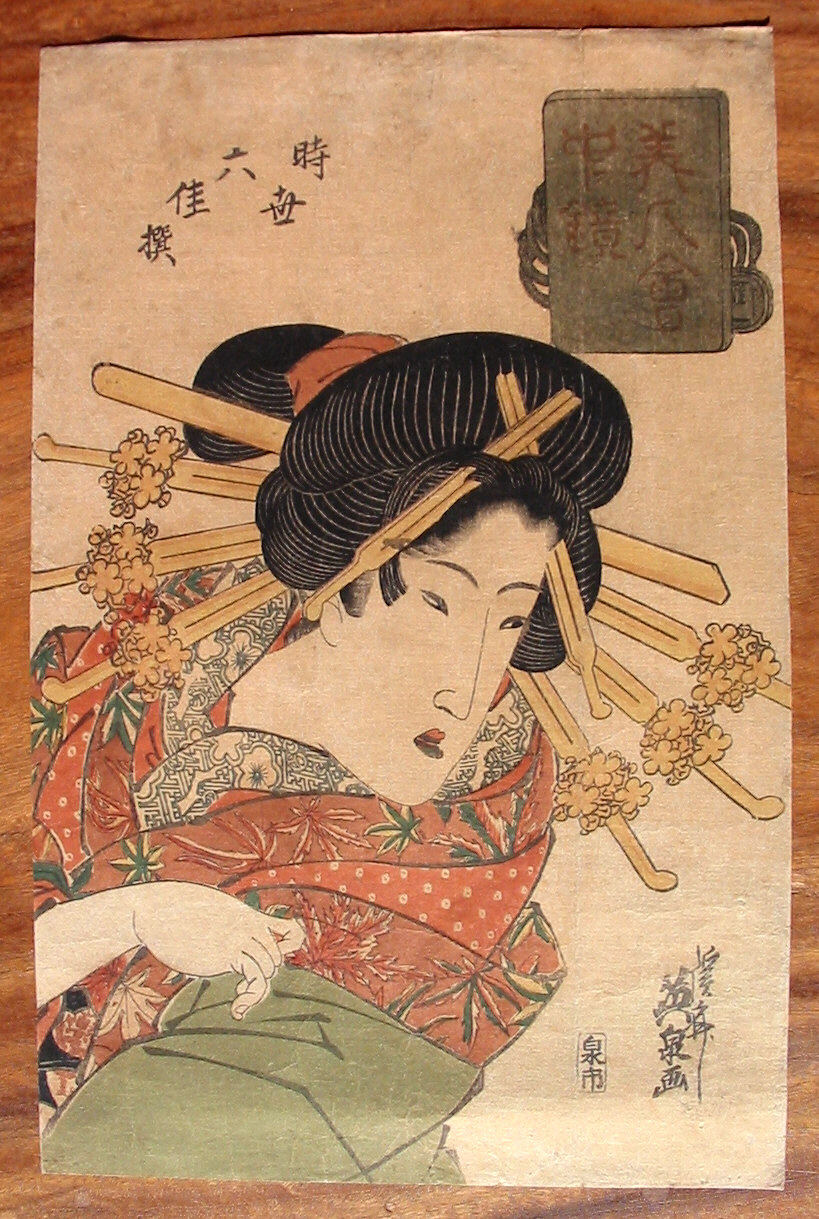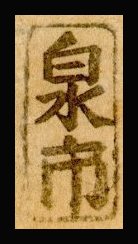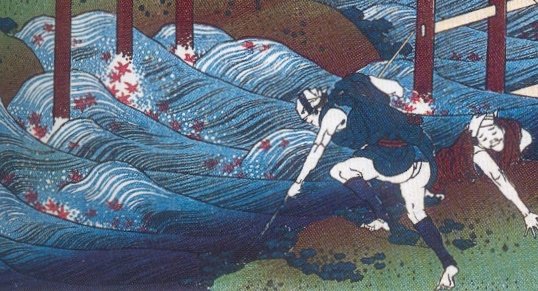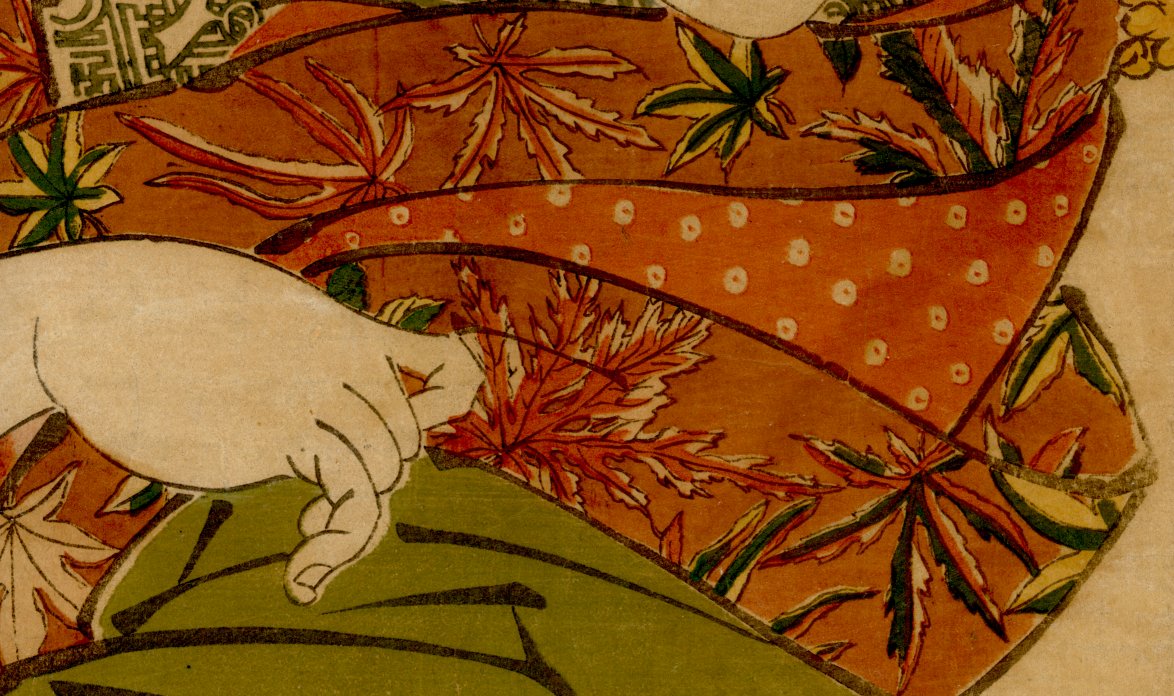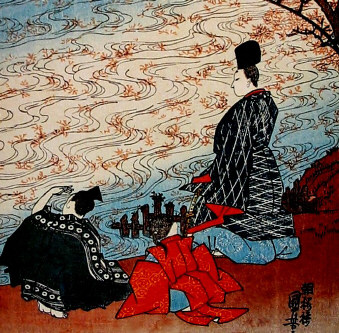
JAPANESE PRINTS
A MILLION QUESTIONS
TWO MILLION MYSTERIES
Ukiyo-e Prints浮世絵版画 |
|
formerly
Port Townsend, Washington |
|
KEISAI EISEN 渓斎英泉 1790-1848 |
|
SERIES: Selection of Six Modern Beauties Bijin kaichu kagami 美人会中鏡 *** 時世六佳撰 Today's Six Poets Tosei rokkasen |
|
Signature: Keisai Eisen ga 署名: 渓斎英泉画 |
|
SIZE: 15" x 9 3/4" |
|
PUBLISHER: Izumiya Ichibei (Kansendō) 和泉屋市兵佳撰 |
|
DATE: Circa 1826-28 Andreas Marks says the publisher's seal used on this page was used in the 1830s. So, the suggested date for this print may be a bit early. We shall do more research and correct this if anything else turn up. |
|
|
|
ORIGINALLY $720.00 NOW ON SALE FOR $490.00 SOLD! |
|
|
|
|
|
|
|
PUBLISHER: Izumiya Ichibei |
|
|
|
|
|
MAPLE LEAVES FLOATING ON THE TATSUTA RIVER |
|
|
|
Above is a detail from a print by Hokusai from the "100 Poets" series. This image is a direct reference to the poem by Ariwara no Narihira. |
|
|
|
"EXCESSIVE IN HEART, DEFICIENT IN WORDS" KOKORO AMARITE, KOTOBA TARAZU 心あまりて言葉足らず |
|
|
|
The print featured on this page was produced almost a thousand years after Ariwara no Narihira (在原業平: 825-880) wrote a poem about maple leaves. That alone speaks volumes about the Japanese sensibilities and their reverence for the past.
Ki no Tsurayuki (紀貫之: ca. 875-945) wrote in the introduction to the Kokinshū that Narihira was "excessive in heart and deficient in words". This ambiguous, or should I say ambivalent, assessment was not in reality faint praise. Rather it was a straight forward appraisal of one of the giants of poetry of the Heian age - at least as Tsurayuki saw it.
Narihira is a fascinating fellow. More is known about him in myth than in fact. True he was a historical figure of royal descent and an accomplished scholar and famous lover, but beyond that mostly what we know of him is the poetry he left behind. Tsurayuki listed him among the six poetic sage, the rokkasen (六歌仙) and Fujiwara Kintō included him in his list of thirty-six of the most eminent poets, the sanjūrokkasen (三十六歌仙). Both lists were frequently portrayed in ukiyo woodblock prints.
Another distinction for Narihira is his connection with the Tales of Ise or Ise Monogatari (伊勢物語), a tale of lovers and their trysts. For ages - I don't know how long - many people believed that Narihira was the author, but scholars no longer see it that way although many of the poems are by him. There is one poem which is often cited where a lover approaches surreptitiously through a crack in a wall. Centuries later the great haiku poet Bashō wrote a poem about a tom cat on the prowl for love - an obvious allusion to Narihira who must have been some kind of Japanese Casanova. Bashō also wrote a haiku about how the fragrance of chrysanthemums made him think of the handsome man from Nara. Who else could it be?
In the section below is the Narihira poem about viewing
maple leaves on the Tatsuta River. We are indebted to our great and learned
contributor Eikei (英渓) for his translation of this poem. Thanks 英渓! |
|
|
|
千早ぶる |
|
|
|
Never, not in the thousand ages |
|
|
|
Chihayaburu |
|
|
|
Above is a detail from the Eisen print featured on this page. It is a direct reference to the Ariwara no Narihira poem about viewing maple leaves floating on the waters of the Tatsuta River in autumn. |
|
|
|
Ariwara no Narihira shown viewing the maple leaves floating down the Tatsutagawa in a detail from a Kuniyoshi print. |
|
|
